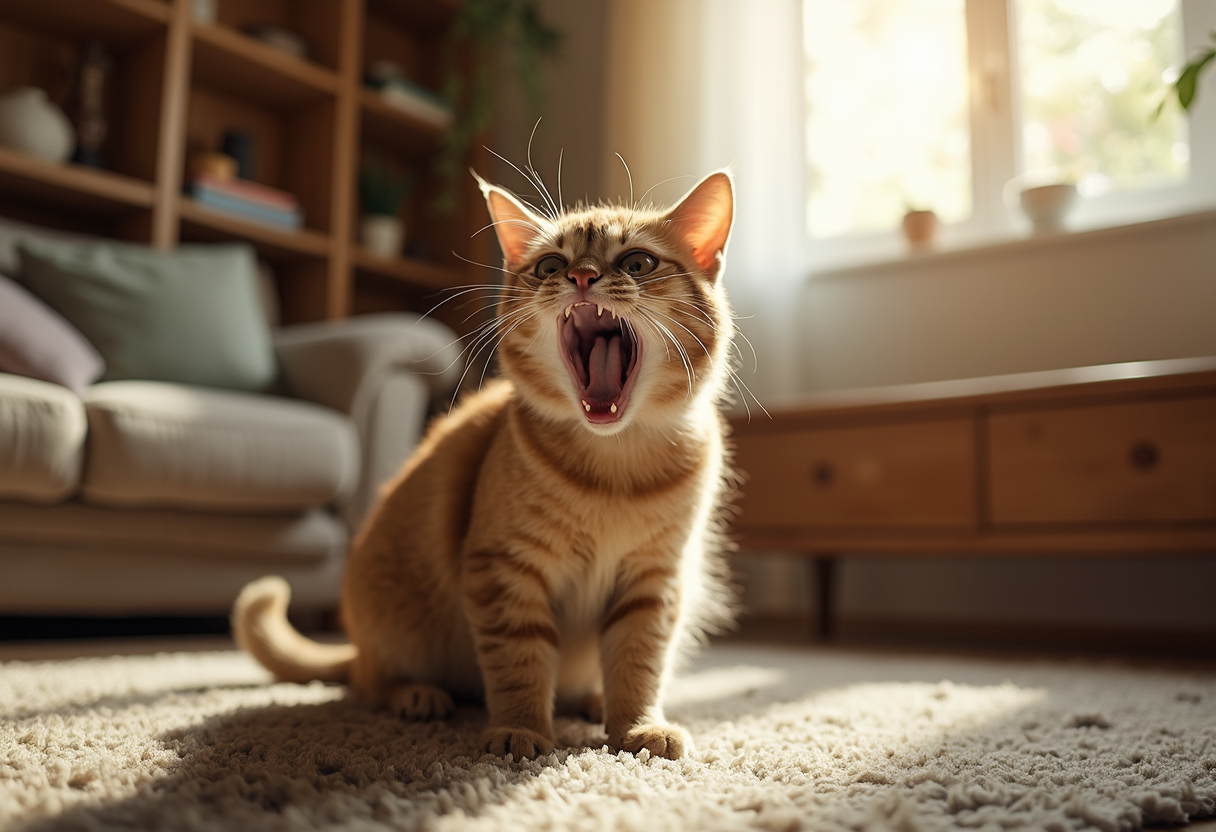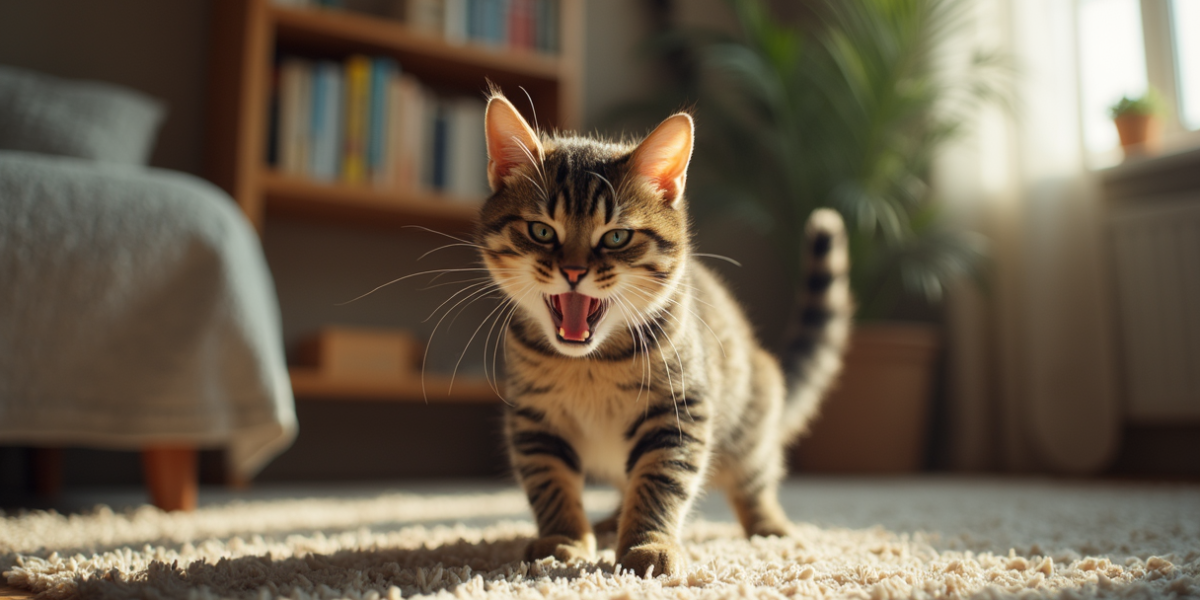Cats are often hailed as independent and enigmatic creatures, but when aggression rears its head, they can transform from serene companions into fiery little beasts. Whether it’s hissing, swatting, or an unprovoked pounce, aggressive behavior in cats can leave pet owners feeling confused and concerned. Understanding the root causes of this feline fury is essential for both the well-being of your cat and the harmony of your household. In this blog post, we will explore effective strategies for managing and mitigating aggressive cat behavior, equipping you with the knowledge to foster a peaceful environment. From recognizing the triggers of your cat’s aggression to implementing behavioral modifications and creating a more enriching space, we’ll guide you in transforming your feisty feline into a more relaxed and affectionate companion. Say goodbye to the chaos and hello to tranquility as we delve into the world of cat behavior and the art of gentle taming.

1. Understanding the Causes of Aggression in Cats
Understanding the causes of aggression in cats is crucial for effectively managing and mitigating this behavior. Cats are complex creatures, and their aggression can stem from a variety of factors, both psychological and environmental. One primary cause is fear; a frightened cat may lash out to protect itself if it feels cornered or threatened. This fear can be triggered by unfamiliar environments, loud noises, or the presence of other animals.
Another common cause of aggression is territoriality. Cats are naturally solitary hunters and can be quite protective of their space. If a new pet or person enters their territory, they may react aggressively to assert dominance or reclaim their comfort zone. Additionally, frustration can lead to aggression. For instance, if a cat sees a bird outside the window but cannot reach it, that pent-up energy may manifest as aggression directed toward people or other pets.
Medical issues can also play a significant role in aggressive behavior. Pain from an injury or discomfort from a health condition can make even the gentlest cat irritable. If you notice sudden changes in your cat’s behavior, it’s essential to consult a veterinarian to rule out any underlying health issues.
Lastly, learned behavior can contribute to aggression. Cats that have been mishandled or poorly socialized during their formative weeks may not know how to interact appropriately with humans or other animals. Understanding these causes can help cat owners develop a compassionate and effective approach to managing aggression, fostering a more harmonious environment for both their pets and themselves. By recognizing the triggers and motivations behind aggressive behavior, you can take proactive steps to ensure your feline friend feels safe, secure, and understood.
2. Identifying Triggers and Warning Signs
Understanding and addressing aggressive cat behavior begins with recognizing the triggers and warning signs that precede an outburst. Cats, like humans, display specific behaviors that can signal their discomfort or agitation. By learning to read these cues, you can intervene before a situation escalates.
One common trigger for aggression is fear. A loud noise, a sudden movement, or the presence of another animal can send a cat into fight-or-flight mode. Signs of fear include flattened ears, dilated pupils, and a low crouch. If you notice these signals, it’s best to give your cat space and avoid any direct confrontation.
Another significant trigger is overstimulation. Cats have varying tolerance levels for petting and playtime. A cat may begin to swat or bite after prolonged interaction, especially if they exhibit signs like flicking tails, twitching whiskers, or sudden body tensing. Recognizing these signs can help you gauge when it’s time to take a step back.
Territorial behavior is also a key factor in feline aggression. Cats are naturally territorial creatures, and the introduction of new pets or even changes in household furniture can provoke a defensive response. Watch for behaviors such as hissing, growling, or an aggressive posture when your cat feels their territory is being encroached upon.
Lastly, medical issues can significantly impact a cat’s temperament. Pain or discomfort caused by underlying health problems can lead to unexpected aggression. If your cat’s behavior changes suddenly, it’s advisable to consult a veterinarian to rule out any medical causes.
By identifying these triggers and warning signs, you can create a safer environment for both you and your feline companion. Understanding their behavior not only helps in preventing aggression but also fosters a stronger bond built on trust and respect.

3. Effective Behavioral Modification Techniques
When faced with aggressive cat behavior, it’s essential to approach the situation with patience and understanding. Behavioral modification techniques can be highly effective in addressing these issues while fostering a harmonious environment for both you and your feline friend. Here are some proven strategies to consider:
1. Identify Triggers: The first step in modifying aggressive behavior is to identify what triggers your cat’s aggression. Is it certain noises, the presence of other pets, or perhaps even specific movements? Keeping a journal of your cat’s aggressive episodes can help you pinpoint these triggers and develop strategies to avoid or mitigate them.
2. Positive Reinforcement: Reward-based training is a powerful tool for altering behavior. When your cat exhibits calm and non-aggressive behavior, provide treats, affection, or playtime as positive reinforcement. This method encourages your cat to associate good behavior with positive experiences, effectively reducing aggressive tendencies over time.
3. Creating a Safe Space: Aggression in cats often stems from anxiety or fear. Creating a safe, quiet space where your cat can retreat during stressful situations can help them feel more secure. This could be a cozy nook equipped with their favorite blanket and toys, or even a dedicated room where they can relax undisturbed.
4. Interactive Play: Engaging in regular play sessions with your cat can help channel their energy and reduce aggressive behavior. Use toys that mimic prey, such as feather wands or laser pointers, to encourage healthy hunting instincts. This not only keeps them entertained but also strengthens the bond between you and your cat.
5. Desensitization and Counter-Conditioning: Gradually exposing your cat to their triggers while rewarding calm behavior can help desensitize them to fear-inducing stimuli. For example, if your cat is aggressive towards visitors, start by rewarding them for remaining calm in the presence of a guest, gradually increasing the exposure over time.
6. Professional Help: If aggressive behavior persists despite your best efforts, consider consulting a veterinarian or a certified animal behaviorist. They can provide tailored advice and assess if underlying health issues might be contributing to your cat’s aggression.
By implementing these behavioral modification techniques with consistency and compassion, you can help your cat overcome aggressive tendencies and foster a more peaceful coexistence. Remember, building trust and understanding your cat’s unique personality is key to successfully taming the feline fury.
4. Creating a Safe and Enriching Environment
Creating a safe and enriching environment for your cat is paramount in addressing aggressive behavior and ensuring their overall well-being. Cats are naturally curious creatures, and providing them with a stimulating habitat can significantly reduce their stress levels and help curb aggression. Start by assessing your living space and identifying areas that can be transformed into feline-friendly zones.
Incorporate vertical spaces, such as cat trees or shelves, to encourage climbing and exploration. Cats love to perch up high, and having these elevated spots gives them a sense of security and control over their surroundings. Additionally, consider adding cozy hiding spots, like soft beds or cardboard boxes, where they can retreat when feeling overwhelmed.
Interactive toys play a crucial role in keeping your cat mentally engaged. Puzzle feeders, feather wands, and laser pointers can stimulate your cat’s hunting instincts and provide opportunities for play without fostering aggression. Regular playtime not only strengthens your bond but also helps to expend excess energy that might otherwise manifest as aggression.
Moreover, ensure that your environment is free from stressors. This includes minimizing loud noises and sudden movements that may startle your cat. If you have multiple pets, provide separate spaces and resources, such as food and water bowls, to reduce competition and territorial disputes.
Lastly, consider using calming products like pheromone diffusers or sprays, which can help create a soothing atmosphere and make your cat feel more secure. By prioritizing a safe, enriching environment, you can significantly mitigate aggressive behavior, fostering a happier and more relaxed feline companion.
5. When to Seek Professional Help
While many instances of aggressive cat behavior can be managed with patience and understanding, there are times when seeking professional help becomes not just beneficial, but necessary. If your cat exhibits consistent aggression that escalates despite your best efforts to modify the behavior, it may be time to consult with a veterinarian or a certified animal behaviorist.
Look for signs that indicate a deeper issue—such as frequent biting, hissing, or swatting, particularly if these behaviors are directed at family members or other pets. Additionally, if your cat’s aggression is accompanied by other concerning changes in behavior, such as withdrawal, excessive hiding, or sudden changes in appetite, it could be indicative of an underlying medical condition that requires professional assessment.
When you decide to reach out for help, be prepared to provide detailed observations about your cat’s behavior, including specific triggers and the frequency of aggressive incidents. A professional will not only help to identify the root cause of the aggression—be it fear, territoriality, or frustration—but also offer tailored strategies and interventions that suit your cat’s unique needs. Remember, early intervention can lead to better outcomes, ensuring both you and your feline friend can live harmoniously together.

6. Maintaining a Peaceful Household with Your Cat
Creating a harmonious home for both you and your feline friend is essential, especially when dealing with aggressive cat behavior. Cats are sensitive creatures, and their environment plays a significant role in how they behave. One of the most effective strategies for maintaining a peaceful household is to establish a consistent routine. Cats thrive on predictability; feeding, playtime, and even grooming should occur at the same times each day. This predictability can help reduce anxiety and stress, making your cat feel more secure in their surroundings.
Additionally, enriching your cat’s environment can significantly diminish aggressive tendencies. Providing various forms of stimulation—such as scratching posts, climbing shelves, and interactive toys—can keep your cat engaged and satisfied, reducing the likelihood of them acting out. Engaging in regular play sessions not only serves as an outlet for your cat’s energy but also strengthens the bond between you both. Use toys that mimic prey, such as feather wands or laser pointers, to tap into their natural hunting instincts and redirect any pent-up aggression in a positive way.
Creating safe spaces within your home is another crucial aspect. Cats are territorial animals, and giving them areas where they can retreat and feel safe can greatly reduce stress and aggression. Consider providing cozy hideaways like cat trees, tunnels, or even simple cardboard boxes where they can observe their surroundings without feeling threatened.
Lastly, be mindful of your own behavior. Cats are highly attuned to their owners’ emotions and reactions. Remaining calm and composed during moments of aggression can help your cat feel more at ease. If you find yourself feeling overwhelmed, take a step back and allow your cat some time alone. This not only helps cool the situation but also reinforces the idea that their space is respected.
By implementing these strategies—establishing a routine, enriching their environment, creating safe spaces, and maintaining a calm demeanor—you can foster a peaceful household where your cat feels secure and happy, ultimately leading to a reduction in aggressive behaviors and a deeper, more loving connection between you both.
In conclusion, navigating the challenges of aggressive cat behavior can be a daunting task, but with the right strategies in place, it becomes a manageable journey towards a harmonious home. We hope our insights and techniques have provided you with the tools you need to better understand your feline friend and reshape their behavior. Remember, patience and consistency are key; while it may take time, positive change is always possible. With the help of pookietales, you can enhance the bond you share with your cat, creating a more peaceful living environment for everyone involved. If you have any questions or would like to share your own experiences, we encourage you to reach out or visit our website for more tips and resources. Thank you for reading, and here’s to a calmer, happier life with your beloved companion!


